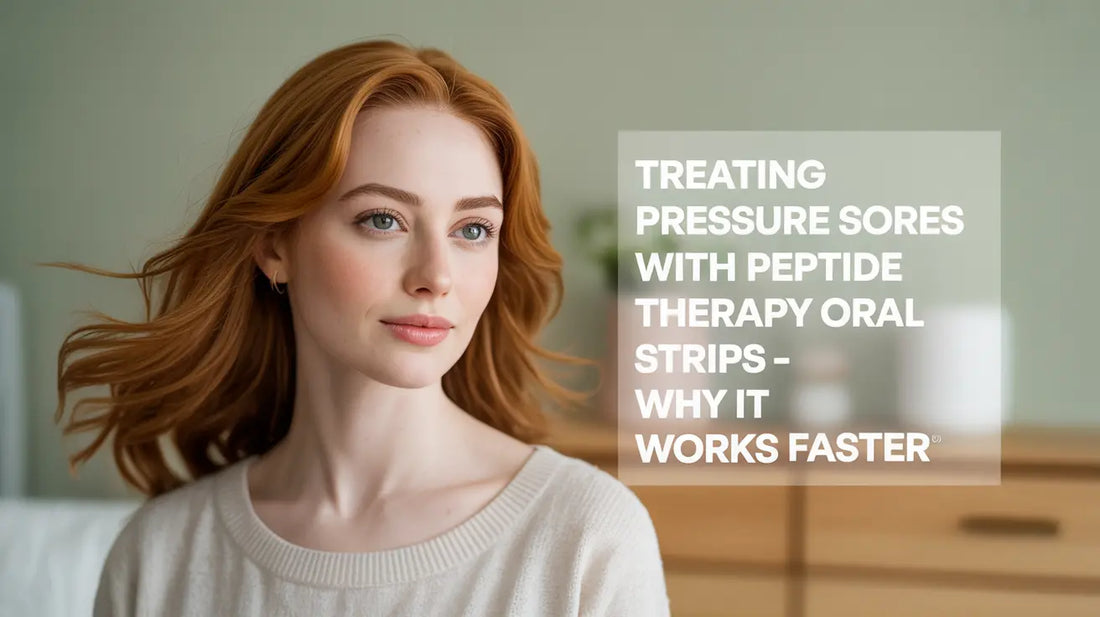
Treating Pressure Sores with Peptide Therapy Oral Strips - Why It Works Faster
Share
Peptide therapy oral strips help treat pressure sores by delivering healing peptides directly into the bloodstream, stimulating tissue regeneration, enhancing collagen production, and improving blood flow to the affected area. This non-invasive method targets the root issues of poor circulation and delayed healing, offering faster and more efficient recovery for bedsores and other pressure-related wounds.
Pressure sores, also known as decubitus ulcers or bedsores, are common in individuals with limited mobility. They form when constant pressure reduces blood flow to the skin, causing tissue breakdown. Peptide oral strips provide an innovative approach to support healing from within.
Why Pressure Sores Are Difficult to Heal
Pressure sores develop due to prolonged pressure on the skin and underlying tissues, usually over bony areas like the hips, heels, or tailbone.
Common complications make these wounds hard to manage:
- Restricted blood flow: Limits oxygen and nutrient supply.
- Chronic inflammation: Keeps wounds from progressing to the healing phase.
- Risk of infection: Open sores are highly vulnerable to bacteria.
- Decreased mobility: Patients may not reposition themselves frequently enough to relieve pressure.
How Peptide Oral Strips Aid Pressure Sore Healing
Oral strips deliver bioactive peptides sublingually, bypassing digestion and entering circulation quickly.
These peptides help in several key ways:
- Stimulate angiogenesis: Encourages formation of new blood vessels to reestablish healthy circulation.
- Increase collagen production: Strengthens tissue structure and accelerates healing.
- Enhance fibroblast activity: Supports granulation tissue development.
- Reduce pro-inflammatory cytokines: Shortens the inflammatory phase, allowing wounds to move into regeneration.
Peptides That Play a Role in Pressure Sore Repair
Several types of peptides have shown strong benefits in chronic wound healing:

- GHK-Cu (copper peptide): Promotes wound closure and skin remodeling.
- Thymosin β4: Aids in tissue regeneration and boosts cell migration.
- LL-37: Offers antimicrobial action and regulates immune responses.
Benefits of Using Oral Peptide Strips for Bedsores
Compared to traditional topical treatments, oral strips work internally, targeting the systemic factors that hinder healing.
Here are key advantages:
- Reaches deep tissue layers: Systemic absorption affects not just the surface but also underlying tissue.
- No skin contact required: Ideal for patients with sensitive or broken skin.
- Improved patient compliance: Simple daily application is easier for caregivers to manage.
Ideal Candidates for Peptide Strip Therapy
Peptide therapy is especially useful for patients with limited mobility or chronic conditions that slow healing.
Best-suited groups include:
- Elderly patients with long-term immobility
- Spinal cord injury patients
- Post-operative individuals with prolonged bed rest
- Diabetics with neuropathy and compromised skin integrity
How to Use Peptide Strips for Pressure Sore Healing
Consistent use is essential to support all stages of wound recovery, from inflammation control to tissue remodeling.
Step-by-step application:
- Apply to a clean, dry tongue: Allow full dissolution for best absorption.
- Use once or twice daily: Follow dosing guidance provided by a healthcare provider.
- Continue use for several weeks: Especially important in chronic wound cases.
Supportive Measures to Maximize Results
Peptide therapy works best when combined with standard wound care practices.
Additional strategies include:
- Frequent repositioning: Every 2 hours to reduce sustained pressure.
- Pressure-relieving mattresses or cushions: Helps distribute weight evenly.
- Nutritional support: Ensures the body has adequate vitamins and protein for healing.
- Hydration and hygiene: Keep skin clean and moisturized to prevent further damage.
Scientific Backing and Clinical Observations
Emerging research supports the use of systemic peptide therapy in chronic wound care.
Key findings include:
- Improved granulation tissue formation
- Faster wound contraction
- Enhanced epithelial coverage
- Decreased signs of inflammation after 2–4 weeks of use
These outcomes suggest that peptide oral strips offer not just symptomatic relief but also accelerate the biological healing process.
FAQs About Treating Pressure Sores with Peptide Therapy Oral Strips
Here are some questions and answers about using peptide oral strips to treat pressure sores:
Can peptide oral strips completely heal a pressure sore?
Yes, when used consistently and alongside proper wound care, they can significantly improve healing and reduce recovery time.
How soon will I see results?
Mild sores may show improvement within 1–2 weeks, while more advanced ulcers may take 4–6 weeks of regular use.
Are peptide strips safe for elderly or bedridden patients?
Yes, they are non-invasive and easy to administer, making them ideal for those with limited mobility or sensitive skin.
Can I use these strips with topical treatments?
Yes, they complement topical care by providing internal healing support while creams or dressings protect and hydrate the wound surface.
Do peptide strips prevent new sores from forming?
While they don't prevent pressure entirely, they may improve skin resilience and tissue health, reducing the likelihood of new ulcers in high-risk patients.
Peptide oral strips represent a powerful new tool in the fight against pressure sores. Their systemic action, ease of use, and proven healing benefits make them an excellent addition to any pressure ulcer care plan—especially for patients who need reliable, non-invasive support for chronic wound recovery.
